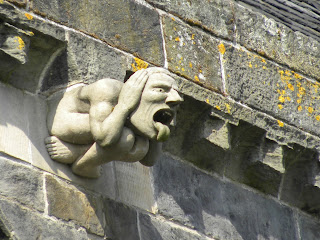I have been busy painting gargoyles, so thought I would make them the subject of this weeks post.
The word gargoyle comes from the middle English word "gargule" and the old French word "gargoulle" both words meaning throat and thought to refer to the noise (gargling) of water rushing from the waterspouts.
The gargoyle disguises a waterspout that directs rain water, collected from the roof of a building, away from the sides of that building.
So they started out as a way of "decorating" the old leaden pipes used as drains on exterior walls of buildings. They were whimsical, fanciful, slightly scary and sometimes downright ugly carved pieces of stone.
Gargoyles are grotesques. Grotesques can also be called chimera.
"The word grotesque, originally a noun (1560s), from Italian grottesco (through Middle French), literally "of a cave," from Italian grotta (see grotto). The original meaning was restricted to an extravagant style of Ancient Roman decorative art rediscovered and then copied in Rome at the end of the 15th century." en.wikipedia.org/wiki/Grotesque
Here is one of my recent paintings, I saw and photographed this one in Paisley, Scotland. I don't think it is a true gargoyle, but it could be. It appears to be part cat, part bird and part lizard or dragon. I haven't thought of a name for this one yet but it is a watercolour.
"Many medieval cathedrals included gargoyles and chimeras. The most famous examples are those of Notre Dame de Paris. Although most have grotesque features, the term gargoyle has come to include all types of images.
Some gargoyles were depicted as monks, or combinations of real animals and people, many of which were humorous. Unusual animal mixtures, or chimeras, did not act as rainspouts and are more properly called grotesques. They serve more as ornamentation, but are now synonymous with gargoyles." https://en.wikipedia.org/wiki/Gargoyle
"During the 12th century, when gargoyles appeared in Europe, the Roman Catholic Church was growing stronger and converting many new people. Most of the population at this time were illiterate, and therefore images were very important to convey ideas. Many early gargoyles depicted some version of a dragon, especially in France. In addition to serving as spouts for water, the gaping mouths of these gargoyles evoked the fearsome destructiveness of these legendary beasts, reminding the laity of the need for the church's protection."
"Human qualities were sometimes ascribed to specific animals—that is, the animals were anthropomorphized. This was especially common for pagans, and using these ideas helped conversion to Catholicism." https://en.wikipedia.org/wiki/Gargoyle
My second painting today is of a chimera or grotesque from Albi, France. This one is from the Catherdral Sainte-Cecile, which has the distinction of being the largest brick church in the world.
I think it is a wolf in sheep-wool disguise, what do you think. Of course it is a watercolour.
What is a gargoyle, where are they and why are they there?
The word gargoyle comes from the middle English word "gargule" and the old French word "gargoulle" both words meaning throat and thought to refer to the noise (gargling) of water rushing from the waterspouts.
The gargoyle disguises a waterspout that directs rain water, collected from the roof of a building, away from the sides of that building.
So they started out as a way of "decorating" the old leaden pipes used as drains on exterior walls of buildings. They were whimsical, fanciful, slightly scary and sometimes downright ugly carved pieces of stone.
Gargoyles are grotesques. Grotesques can also be called chimera.
"The word grotesque, originally a noun (1560s), from Italian grottesco (through Middle French), literally "of a cave," from Italian grotta (see grotto). The original meaning was restricted to an extravagant style of Ancient Roman decorative art rediscovered and then copied in Rome at the end of the 15th century." en.wikipedia.org/wiki/Grotesque
Here is one of my recent paintings, I saw and photographed this one in Paisley, Scotland. I don't think it is a true gargoyle, but it could be. It appears to be part cat, part bird and part lizard or dragon. I haven't thought of a name for this one yet but it is a watercolour.
"Many medieval cathedrals included gargoyles and chimeras. The most famous examples are those of Notre Dame de Paris. Although most have grotesque features, the term gargoyle has come to include all types of images.
Some gargoyles were depicted as monks, or combinations of real animals and people, many of which were humorous. Unusual animal mixtures, or chimeras, did not act as rainspouts and are more properly called grotesques. They serve more as ornamentation, but are now synonymous with gargoyles." https://en.wikipedia.org/wiki/Gargoyle
"During the 12th century, when gargoyles appeared in Europe, the Roman Catholic Church was growing stronger and converting many new people. Most of the population at this time were illiterate, and therefore images were very important to convey ideas. Many early gargoyles depicted some version of a dragon, especially in France. In addition to serving as spouts for water, the gaping mouths of these gargoyles evoked the fearsome destructiveness of these legendary beasts, reminding the laity of the need for the church's protection."
"Human qualities were sometimes ascribed to specific animals—that is, the animals were anthropomorphized. This was especially common for pagans, and using these ideas helped conversion to Catholicism." https://en.wikipedia.org/wiki/Gargoyle
Here are a few of my photographs of gargoyles and grotesques from Paisley, Scotland:
I think it is a wolf in sheep-wool disguise, what do you think. Of course it is a watercolour.
My last painting today is of a chimera or grotesque from the Notre Dame Cathedral in Paris, France.
This one I think I will call "Fury", also a watercolour:
Well that is all for today, thanks for dropping by,
happy Wednesday, with whimsy,
Gillian









No comments:
Post a Comment